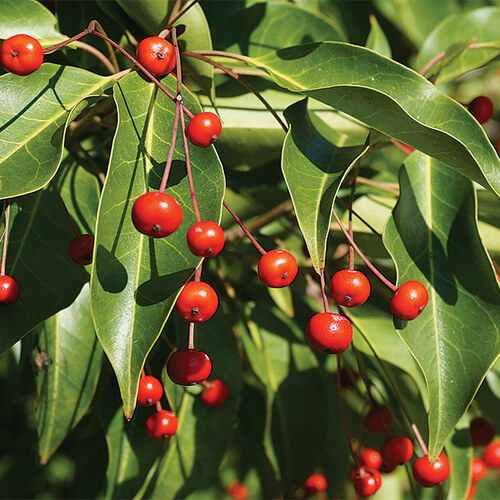[ad_1]
Our gardens can be valuable habitats for birds, providing nutritious food, nesting sites, and life-saving shelter, especially during the coldest months when overwintering birds are challenged. If we are mindful of these basic needs as we design our beds and borders, we will be rewarded with a landscape rich in birds. Here are some things you can do to help our feathered friends when times are lean. Learn more about what plants to put in your yard to help birds survive through winter.
Provide food sources
While many of the plants featured here help feed birds throughout the year, it’s especially important to provide nourishment during the late fall and winter, when birds need it the most. These three plants can help feed birds during that time of year.
1. Winterberry (Ilex verticillata, Zones 3–9). I’ve seen winterberry literally shaking with flocks of American robins and cedar waxwings until every red berry was eaten. The fruit can persist into February, providing months of sustenance.
2. Northern bayberry (Myrica pensylvanica syn. Morella pensylvanica, Zones 3–7). This shrub’s nutritious, waxy, powderblue fruits help sustain bird populations through bitter winters.
3. Flowering dogwood (Cornus florida, Zones 5–9). During fall migration, this native tree offers red, fleshy fruit to bird species such as thrushes and grosbeaks, who must replenish vital fat reserves before flying to their wintering grounds.

Don’t clean up in the fall
Keep your loppers or pruners in the shed, and consider leaving your perennials intact until early spring. Numerous perennials, such as purple coneflower (Echinacea purpurea, Zones 3–9) or many of our native grasses, become natural bird feeders once their seeds mature.
Plant dense evergreens
Including a diversity of conifers and broad-leaved evergreens in the landscape will provide vital shelter for birds in winter. I have found semi-dwarf pines (Pinus spp. and cvs., Zones 2–9) or large-leaved rhododendrons (Rhododendron spp. and cvs., Zones 3–9) to be particularly attractive to birds not only for winter protection but also as nesting sites.
Provide water
Birds get thirsty too, so consider adding a reliable year-round water source to keep them hydrated.
Andy Brand is the director of horticulture at Coastal Maine Botanical Gardens in Boothbay.
[ad_2]
